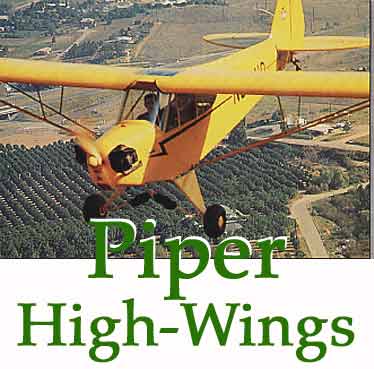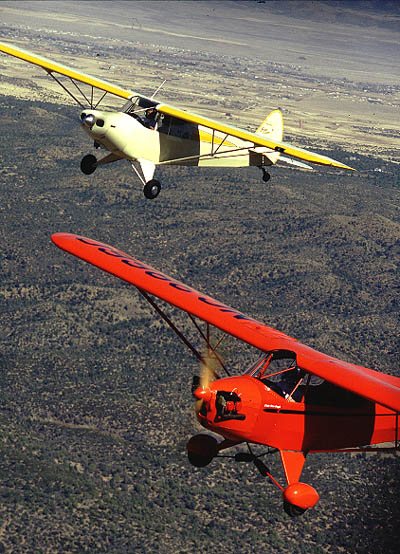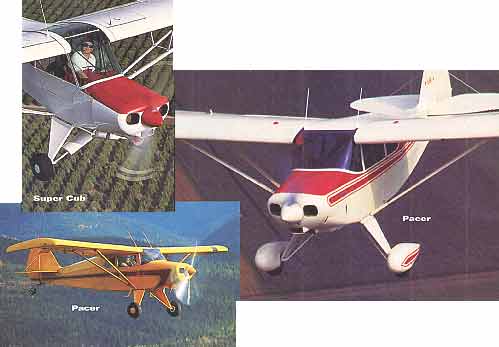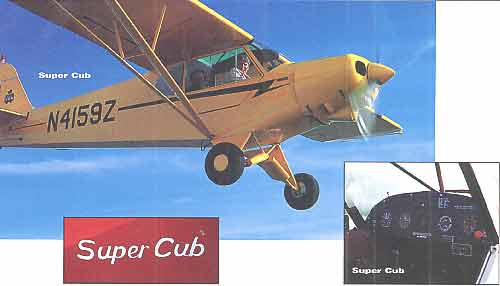
Budd Davisson, Plane and Pilot Magazine,
"...and in the begining, there was the high wing Piper and He looked down and said...yeah, that's good, really good."
Cub to Colt and all the Rag- and-Tube Wonders Inbetween

Budd Davisson, Plane and Pilot Magazine,
"...and in the begining, there was the high wing Piper and He looked down and said...yeah, that's good, really good."
Cub to Colt and all the Rag- and-Tube Wonders Inbetween
Back in its high-wing days, pre-1963, Piper Aircraft really only designed one airplane, the J-3 Cub and even that wasn’t a new design. Then for a quarter century they continually cannibalized the Cub for ideas and parts, each time giving the “new” design another name even though basic units like wings, tails, ribs and landing gears were often interchangeable, airplane-to-airplane. Old Bill Piper couldn’t see designing a new part when something they already had on the shelf would work just as well.
The Piper family tree evolved in a very linear fashion with just one major branching-out taking place in 1948 when the PA-15 Vagabond came out. That fork in the road gave birth to two distinct families of Piper high-wing airplanes—the clan of the Long Wing and that of the Short Wing. It could logically be asked exactly what the definitions of Long and Short include. It’s pretty simple—Long Wing Pipers all had wings a shade over 35 feet long while the Shorties ran a little over 29 feet. Regardless of which clan and airplane you’re discussing, however, until the end of the Piper high-wing dynasty, none of them strayed far from the formula laid down by chief engineer, Walter Jamineau, with the J-3.
-Steel tube fuselage
-Bungee sprung “V” gear
-Fragile aluminum ribs made of riveted-together “T” shaped sections
-Trim via screw-jack moving forward edge of stabilizer up and down
-Steel, sealed struts
In the Beginning All Wings were Long
 |
J-3 Cub
Although other engines were offered in the J-3, the 65 hp, Continental
A-65 became the engine of choice and it made the J-3 a huge improvement
over earlier Cub variants. On 65 hp, the airplane flies well,
but the 85 hp conversions make a real airplane out of it. With a
touchdown speed a little over 30 mph, the airplane is the standard
for simplicity both in flying and in maintenance. One maintenance
item worth noting, however, are the original expander tube brakes
that can cost a fortune to overhaul. Also, most post-war Cubs
have aluminum wing spars, not wood, and that’s
worth paying a premium.
With a 75 mph cruising speed, the Cub isn’t going to take you very far very quickly, but you’ll
enjoy every second of it. The front seat is a little cramped
and blind while the back seat is more or less comfortable with
great side visibility. The airplane is made for sunset cruising
with the side door open.
The Cub is one of the most expensive two-place classics you can
buy, which is a function of its popularity. It’s hard to believe it takes $20K to get into the game and even harder to believe we’re
seeing restored specimens fetching in excess of $40K. Since the
airplane will fit into the new Sport Pilot category, the prices
will just keep going up.
J-4 Cub Coupe.
The J-4 is, a side-by-side Cub. Period. Everything else is the
same. The engine was cowled in an effort for more speed, but
they didn’t get it. It’s still an 80 mph airplane, but, like the Cub, it’s
only burning a little over four gallons an hour.
Although the Coupe appears the same as its peer group, the Luscombe,
Aeronca Chief and Taylorcraft, there’s one major difference (besides
being slower): the visibility is much better. The wing is mounted
just a little higher and it really improves the way the cockpit
feels.
J-4 Cub Coupes have never been as popular as the J-3 and assuming both airplanes are the same quality, the J-4 will usually be priced a solid 20% lower than a Cub.
 |
J-5 Cruisers
The J-5 Cruiser clan can be a little confusing because Piper
used the same airframe and gave it two designations, J-5A, B,
and C and then PA-12 Super Cruiser. In any case, the airplane
is sometimes referred to as a “Fat Cub” because of the way the fuselage swells out as it passes the pilot to accommodate the supposedly two-people wide back seat. It was Piper’s
attempt to build a three-passenger airplane and they came close,
as long as the back passengers are slim of butt and like each
other a lot.
The J-5 moves the pilot to the front seat and jacks him up a
little so he or she can almost see over the nose on the ground.
Also, because the fuselage widens out, the shoulder/fanny room
for the pilot is almost excessive—quite a shift from the tight-as-Spandex
Cub. This is a real Big Guy airplane that changed quite a bit
as it matured.
J-5s have lagged far behind the Cub in price (hasn’t everything?) but they are quickly closing the gap because so many have been re-engined with bigger (150 hp being the most common) engines and outfitted for bush duty. When a larger engine is coupled with the Cruiser’s
wide fuselage, you have a perfect platform for utilitarian flying.

PA-11
For some reason the PA-11 never had a cute name of it’s own, possibly because it is nothing more than a J-3 with either a 65 hp or 90 hp Continental enclosed in a nicely streamlined cowl. The PA-11 is considered by many to be the ultimate pure Cub because with the big engine, it has terrific performance and cruises 90-95 mph, which is lightning quick compared to a J-3. They are commanding Cub prices-plus and they are worth it.
PA-12 Super Cruiser
The Super Cruiser is a post war refinement of the J-5C. Structurally, the major change was replacing the low carbon steel tubing in the fuselage with chrome-moly but the marketing department got in the act and gave the airplane a greatly redesigned cockpit and instrument panel. All sorts of minor refinements made it more finished looking, plus they moved the front seat back a few inches, which made the front pit positively roomy.
Here too, big engine conversions can drive the prices up to $35-$40K, but figure on the mid-twenties for a good airplane.
PA-14 Family Cruiser
The first serial-production, four-place Piper, the Family Cruiser took the J-5 concept of widening a single seat to 1 3/4 seat and applied it both front and rear making room for two skinny people to fit up front and in back. The airplane is pure Cub in everything it does but it has 115 horses to play with. Few of the airplanes were built and they are dearly loved by those who own them. Again, you see a lot of them all bushed-out with big engines, flaps added, fat tires, etc. None of them are cheap, since they start at $20-$25K.

PA-18 Super Cub
First of all the PA-18 is out of sequence, but it is definitely of the long wing variety and, if there is an airplane as legendary as the J-3, it is the Super Cub. This is the very definition of utility and it is also the last of the long-wing Pipers. In it’s earliest configurations it had 90 hp and no flaps and the only thing that separated it from the J-3 and PA-11 before was that the wing attach structure was moved from over the pilot’s head to the outside of the fuselage giving more head room.
The 125 and 135 hp Super Cubs are well respected airplanes and hover in the $35-$45K range while the most common150 hp version with big flaps, can cost anything from $45K to $150K with several custom built examples hitting $250K (really!).
The airplanes hold their value so well because they do their job so well. At 105 mph cruise they are leisurely cross-country machines, but they are the airplane of choice for the utility pilot.
Go To Page Two
Shortwing Piper Club
www.shortwing.org
220 Main Street
Halstead, KS 67056